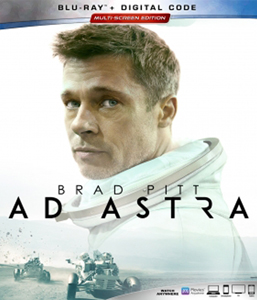I’d be lying if I said I didn’t enjoy watching “Ad Astra” (2019). Director James Gray’s film blends a solar system travelogue with the family drama of Brad Pitt’s Roy McBride hoping to connect with his estranged father, Clifford (Tommy Lee Jones). Clifford is on a spaceship orbiting Neptune as Roy starts off from Earth. “Ad Astra” is one big metaphor about a gulf in a relationship, but its space-porn visuals and the delicate, somber music from Max Richter made it irresistible for me. (Other viewers will find it too slow; this is a matter of taste.)
The style of hard SF, but without the science
So I do recommend seeing the film. That said, the most interesting talking point of “Ad Astra” is a troubling one: Like “Interstellar” (2014) – but on the scale of the solar system rather than the universe – the movie is in the style of hard science fiction (wherein the laws of physics and science are adhered to), yet it is actually a space fantasy film (where those laws are not adhered to).
The slow pace, luscious visuals and music, and contemplative voiceovers from Roy all make a viewer think of “2001” and “Contact” and “Gravity,” yet “Ad Astra” brazenly breaks free from science fact when it feels like it.

“Ad Astra” (2019)
Director: James Gray
Writers: James Gray, Ethan Gross
Stars: Brad Pitt, Tommy Lee Jones, Ruth Negga
(Spoilers follow.)
Gray and co-writer Ethan Gross cue us early on that they are not interested in real science. Roy falls from an Earth-orbit space antenna to the planet’s surface, saving his life with a basic parachute. “Ad Astra” is set in the near future, so Roy’s space suit looks modern – there’s nothing to indicate that it could save the astronaut from turning into a human meteorite. Also, the antenna is in orbit, so Roy should be too, right?
Maybe this weird sequence is “Ad Astra’s” way of preparing us for the scientific cheats to follow, such as the short (compared to real physics) transit time across the solar system. Again, this is the near future, and if there has been a discovery and development of new propulsion systems in the meantime, the film doesn’t show or mention it.
“Ad Astra” often luxuriates in the perfection and standardization of current tech. Roy’s space shuttle journey from the Earth to the Moon is similar to a plane flight, although he does wear a space suit and a pillow costs $125, which he buys by scanning his fingerprint.
Gorgeous peek into the future
In a brilliant shot, Gray and cinematographer Hoyte Van Hoytema (“Interstellar”) use the precise camera framing of the Apollo 11 lunar lander touching down on the Moon. But it’s a trick of perspective: The landing pad isn’t entering a small crater but rather a large one; a whole spaceport exists inside.

The landing process on Mars is a little different; this time they are in one of those reusable rockets – pioneered by Space-X – that can land in the same position it starts from.
It’s not just in the mundane travel that “Ad Astra” shows us a near future, but also in the scary things. The Moon is the new Wild West, and Roy’s group is attacked by a convoy of Moon pirates.
While the Earth is the prettiest of the planets and moons (maybe I’m biased, as an Earthling), the other globes remain pure, not weighed down by humanity’s history of conflict. So this sequence effectively evokes anger. I think: Why can’t the rest of the solar system remain free of Earth-based pettiness?
Speaking of beauty, the film’s final act takes place at Neptune. The ringed planet’s dark blue hue – not precisely found in nature on Earth – evokes beauty, but also undefined fear. This is why it’s a great setting for “Event Horizon” (1997) (or maybe it’s that film that makes me think of Neptune as scary), and it’s also perfect for the tense and emotional finale here. Pluto was downgraded to a proto-planet for scientific reasons, but it also makes emotional sense that Neptune should be the last planet: the gateway into the frightening unknown.
Characterization before plot
I suspect Gray and Gross put the characterization before the plot when writing the screenplay. A son and father separated by the vastness of the solar system is a powerful idea, but then you need to give Clifford a mission that takes him out there.
We get an explanation that makes little scientific sense. Clifford and his team are searching for signs of extraterrestrial life. We are told no reason why they physically have to be far away from Earth to conduct this search; humanity has sent probes even farther into space.
And then there’s the film’s time-clock/urgency element. Electromagnetic flares keep sweeping through Earth, the Moon, Mars and the inner-planetary space stations, coming from Clifford’s Lima Project. The answer to if or how or why Clifford is sending dangerous flares through space is never explained.
A magic trick of sorts
So in the end, “Ad Astra” is a magic trick of sorts. Pitt and Jones are excellent, and there’s also a nice turn from Donald Sutherland as another veteran astronaut, and “Agents of S.H.I.E.L.D.’s” Ruth Negga imparts a key bit of information to Roy at mid-film. We get little mini-arcs, such as a pilot who freezes under pressure, and snapshots of the future, like the dangers of animal experimentation on a space station.
Roy’s voiceover observations are engaging, like when he mulls pictures of colorful out-system planets and then contrasts that with the lack of life on those spheres. “Ad Astra” asks us to mull emptiness and loneliness, as most of Roy’s thoughts have meaning to both humanity’s place in the cosmos and his relationship with his dad. It’s often a gorgeous piece of philosophical, meditative art.
But the plot is under-explained and malformed, and the science is wrong (sometimes absurdly so) more often than it’s right. I enjoyed the experience of watching it, but “Ad Astra” is ultimately frustrating. It could’ve been a hard-SF masterpiece, maybe even this generation’s “2001,” if it cared about getting the science right.

